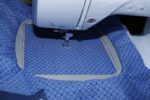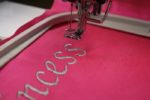How To Sew Elastic Directly To Fabric
It’s not always easy to unleash the potential of elastic in your designs. Ready-made dresses have this feature, but it can be done much easier on yourself with a little know-how and creativity. And the best part about sewing elastics directly onto fabric is that you get total control over its size. Today, we will share the methods that would allow you to have a complete insight on how to sew Elastic directly to fabric. Moreover, there is no need for needles or threads when there is crocheting at hand instead.
How To Sew Elastic Directly To Fabric Methods?
Setting up the elastic material with the garment can be explained with the help of two methods.
- Setting the elastic on your garment
- Casing for elastic on your garment
Method 1: Setting the elastic on your garment
Materials required
Setting up the elastic material with the garment requires materials are
- Sewing machines
- Cutters
- Pins
- Chalk
- Measuring tape
- Thread
- Elastic
Taking the measurement
Measuring your body part and purchasing a specific amount of elastic will help you purchase the right size elastic. If you have no idea what a person’s waist measurements are. Then you need to attach an elastic around a wrist or neckline of the person to have the perfect measurement. Ensure that it fits comfortably and that you will have room to adjust it in the future if necessary.
Connecting the ends
Elastic ends must be sewed together for sewing. Sew them 2-3 times using a zigzag stitch to ensure any of these will not become stuck on anything when not worn, and then overlap by 0.64cm or 0 inches. Furthermore, you want to avoid overlapping due to bulging issues. However, you still need the fabric to have a certain amount of giving.
Pinning the Fabric
Make sure to pin up the elastic evenly between the seams of your fabric. It can be placed 1/2 inch or 0.64 centimeters below your sewing line for a classic look, though you may want to go higher if you make a top with this type of placket (e-collar or dress). And the stitched edge is now one side since an elastic band divides these two pieces into four equal sections.
Sewing the Elastic
Sewing the band with the fabric is the next step. Zigzag stitch down, starting at the top, ensuring the length is equal. Simply overlap where necessary until everything looks even if any points are too short or long.
Folding of Fabric with Elastic
Fold over the elastic so that it touches the fabric once you have finished cutting it. Both flexible fabrics need to be pinned in place and stitched with even stitch lengths and widths using an up-and-down motion. Further, to stitch, we need to overlap the raw edges by about 2 inches.
Setting the edges
Once you have folded over the edge of the leftover fabric and attached it with a zigzag stitch. You want both the elastic and the fabric to be flat against each other before sewing. So that they do not shift when the sewing is done. Also, along the bottom half of the seam, make sure all edges line up perfectly. In addition, during this step, make sure that you are turning your foot in the direction of the needle, as shown in the above picture.
Make long horizontal rows across the entire product, starting at the top left corner and ending at the rear right corner. A U-shaped curve is formed at the start of the leg, which is the general breakpoint for most users. Turn the fabric over after stopping the machine and stitching back up.
Sewing the top of the garment
Make sure to overlap your stitches with each other, as shown above. And when sewing from the bottom edge of the cloth to the top of the elastic. After wearing them frequently, this prevents them from coming apart or undoing.
Finishing
Now that you have a fabric attached to an elastic band give it a finished appearance and feel. Further, the additional material can then be trimmed away along the stitching line. The stitching can then be washed and dried.
Method 2: Casing for elastic on your garment
Materials required
Setting up the elastic material with the garment requires materials are
- Sewing machines
- Cutters
- Pins
- Chalk
- Measuring tape
- Thread
- Elastic
Elastic Width
When making the case, you’ll need to know how wide the band is. If the case is larger than the band, you’ll have to make it. Further, after adding 1.3 cm or 0.5 inches to the band’s width, you have the band’s measurement. For instance, a 0.5inch ring measures 100cm long. And after adding the additional 0.5inch to your final size, your final size will be 1inch.
Folding the fabric
To fold the fabric inward, use the measurement you just took. Using this approach, the material’s extra edge will be hidden behind the fold. Folding the fabric evenly around the cuff will yield a neat finish, and pinning the cloth will keep it in place until it is time to sew. Moreover, to summarize, when creating your case, fold 1 inch of cloth inward.
Markings
For the elastic band to be inserted into the case, there must be an opening. The opening will be sewn after the bar has been inserted and connected. Using a pin or chalk, mark the beginning of the opening before stitching. Furthermore, the band should be able to slide easily through the opening. Make an opening of 1.9cm or 2.5cm for an elastic of 1.3cm.
Sewing
The next step is to sew the edge of the fabric as you have folded it. Instead of using your machine’s zigzag stitch, give a straight stitch. Start at the edge of the cloth and stitch about 0.25 inches away. As a result, the elastic will be held in place, and there will be adequate room for it to move. If the opening is not sewn, the elastic will be held in place.
Preparations
We can now insert the band into the casing after you finish fiddling with the casing. However, what should the band length be? Using the same step as above, wrap it around the person’s body size. If you’d like a snug fit, subtract a little length from your measurement, such as 0.5inches.
Safety Pin attachments
An end of the band should be attached with a pin. You can then circumvent the hook by inserting it from one end and pulling it all the way around. If possible, keep the nail within the fabric’s middle to prevent it from sticking to the edge.
Insertion of pins
The title of this step says it all. Put the pin through the opening and close it. You can remove the pin from the fabric by taking it all the way around the waist area.
Stretching the Fabric
Put the band on the cloth by stretching it back and forth. Don’t allow the pin to come undone.
The Other End
You need to secure the other end outside while you are inserting one end. Do not allow it in with the other end. Take a pin to attach it to the fabric if you find it difficult to keep on the other end.
The Ends
You should remove the end of the cloth once you have successfully inserted the whole band. When you remove the safety pin, you should match up the ends and stitch. When sewing the band’s ends together, overlap them by 0.25 inches or 0.64 cm or 0.5 cm or 1.3 cm, then cross the elastic with a zigzag stitch.
Closing
In the end, this is the last step in which you have to close the sewed openings of your fabric. All you have to do is tug the band to cover all crew before the casing is tightened.
FAQs
What stitch do you use to sew elastic?
Then sew across the overlapping elastic two or three times with your sewing machine's zigzag stitch setting. Your elastic ends will now be securely connected, and sewing elastic ends together with scrap fabric is another option.
What tension should I use for elastic?
Stretching elastic should only be done between 3 and 8%; 8% should only be used on the small parts of the garment. You need to consider one more thing, and that is putting more stitches on the side where you think the elastic is stretched more.
Why won't my sewing machine sew through elastic?
Sewing elastic requires adjusting the seam allowance, which is the most common mistake. Additionally, you should lower the foot pressure and adjust the lower threads to the tensions of the bobbins. Further, it can cause elastic to not sew well on your garment when using a pressure foot instead of a walking foot.
Conclusion
You can now sew elastic directly to the fabric and customize it whenever you want. Be careful while using pins or machines since they may cause damage easily if not used correctly. Moreover, with these two methods, you would have the perfect answer to your question of how to sew elastic directly to fabric.





